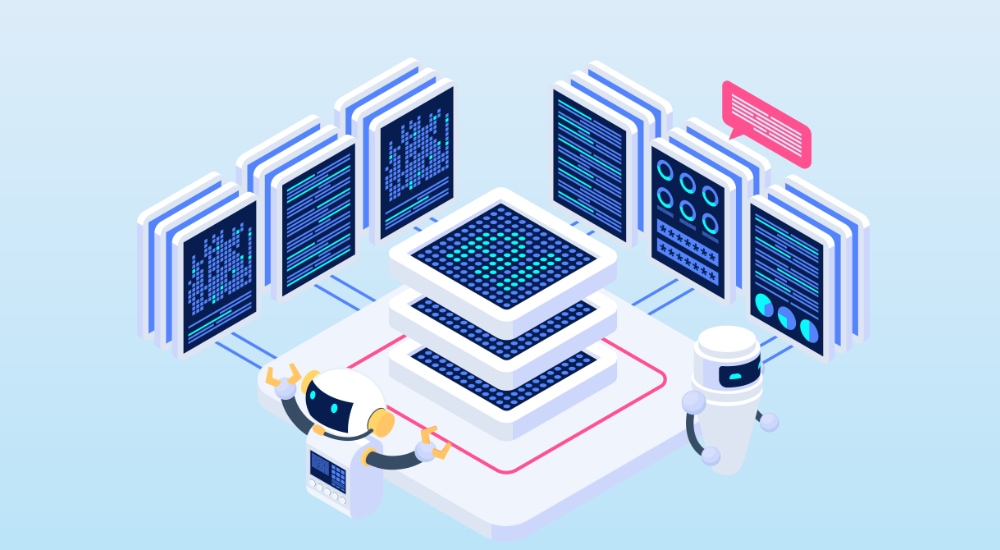
In today’s fast-paced digital landscape, businesses face numerous challenges in managing their IT infrastructure and ensuring optimal performance. Traditional approaches to IT operations management often fall short in addressing the complexity and scale of modern systems. However, advancements in artificial intelligence (AI) and data analytics have paved the way for a revolutionary approach called AIOps, which stands for Artificial Intelligence for IT Operations.
Introduction to AIOps
In this article, we will explore the concept of AIOps, its benefits, key components, use cases, implementation considerations, and the future of this transformative technology. AIOps combines the power of AI and machine learning with big data analytics to provide organizations with actionable insights, automated processes, and intelligent decision-making capabilities
What is AIOps?
AIOps refers to the application of AI, machine learning, and big data analytics techniques to IT operations. It aims to enhance the overall efficiency, reliability, and agility of IT systems by automating manual tasks, detecting anomalies in real-time, and providing predictive insights for proactive problem resolution. By harnessing the vast amounts of data generated by IT infrastructure, AIOps empowers organizations to gain deep visibility, drive efficiency, and deliver exceptional user experiences.
The Benefits of AIOps
Improved Efficiency and Productivity
One of the primary benefits of AIOps is the significant improvement in operational efficiency and productivity. Traditional IT operations often involve manual, time-consuming tasks such as log analysis, troubleshooting, and incident resolution. AIOps automates these processes, allowing IT teams to focus on more strategic initiatives and higher-value tasks. With AIOps, organizations can streamline their operations, reduce mean time to repair (MTTR), and achieve higher service levels.
Proactive Issue Detection and Resolution
AIOps enables proactive issue detection by leveraging machine learning algorithms to identify patterns, anomalies, and potential incidents in real-time. By continuously monitoring and analyzing vast volumes of operational data, AIOps platforms can detect subtle deviations from normal behavior, alerting IT teams before they escalate into major problems. Proactive incident resolution minimizes downtime, improves system reliability, and enhances overall user satisfaction.
Enhanced Decision Making
With the help of AI and advanced analytics, AIOps provides IT teams with actionable insights and contextual information for informed decision-making. AIOps platforms can aggregate and correlate data from various sources, such as logs, metrics, and events, to provide a holistic view of the IT environment. Armed with these insights, organizations can make data-driven decisions, optimize resource allocation, and prioritize critical issues, resulting in improved operational efficiency and better business outcomes.
Faster Incident Response
Traditional incident response processes often rely on manual interventions and reactive approaches. AIOps revolutionizes incident response by leveraging AI and machine learning capabilities to automate the identification, analysis, and remediation of incidents. By rapidly detecting and diagnosing issues, AIOps reduces the time required to resolve incidents, minimizing their impact on business operations. Real-time incident response enables organizations to maintain high service availability, mitigate risks, and ensure seamless user experiences.
Key Components of AIOps
AIOps comprises several key components that work together to deliver its transformative capabilities.
Machine Learning
Machine learning forms the backbone of AIOps. It involves training algorithms to recognize patterns, detect anomalies, and make predictions based on historical and real-time data. By applying machine learning techniques to operational data, AIOps platforms can uncover hidden insights, identify performance bottlenecks, and predict potential issues before they occur.
Big Data Analytics
AIOps leverages big data analytics to handle the enormous volume, velocity, and variety of data generated by IT infrastructure. Through advanced data processing and analysis techniques, AIOps platforms are able to extract meaningful insights from diverse data sources, including logs, metrics, events, and user behavior data. Big data analytics enables organizations to identify trends, correlations, and patterns that can uncover root causes of issues and provide actionable intelligence for proactive decision-making.
Automation
Automation is a critical component of AIOps, as it eliminates manual, repetitive tasks and accelerates processes. AIOps platforms automate various aspects of IT operations, such as incident detection, ticketing, remediation, and even infrastructure provisioning. By automating routine tasks, IT teams can focus their efforts on more strategic activities, improve efficiency, and reduce human errors.
Artificial Intelligence
Artificial intelligence plays a vital role in AIOps by enabling intelligent decision-making and cognitive capabilities. AI algorithms can process complex data sets, perform natural language processing, and make recommendations based on historical and real-time data. AI-powered chatbots and virtual assistants also enhance user support and enable self-service capabilities, further improving operational efficiency.
Use Cases of AIOps
AIOps has a wide range of applications across various domains. Let’s explore some of the key use cases:
IT Operations
In the realm of IT operations, AIOps can automate infrastructure monitoring, log analysis, and incident management. It enables proactive identification of performance issues, capacity planning, and resource optimization. AIOps platforms can also provide predictive insights to prevent outages, minimize downtime, and ensure optimal system performance.
DevOps
AIOps integrates seamlessly with DevOps practices by streamlining the deployment, monitoring, and management of applications. It enables the continuous monitoring of application performance, code quality, and infrastructure health. By leveraging AIOps, organizations can achieve faster release cycles, improved collaboration between development and operations teams, and enhanced application reliability.
Application Performance Monitoring
AIOps plays a crucial role in application performance monitoring (APM) by providing deep insights into application behavior and user experiences. It can detect anomalies, identify performance bottlenecks, and correlate application metrics with infrastructure performance. AIOps-powered APM solutions enable organizations to optimize application performance, deliver exceptional user experiences, and improve overall customer satisfaction.
Security Operations
AIOps enhances security operations by leveraging AI algorithms to detect and respond to cybersecurity threats. It can analyze vast amounts of security-related data, including logs, network traffic, and user behavior, to identify suspicious activities and potential breaches. AIOps helps organizations detect and respond to security incidents in real-time, strengthen their security posture, and proactively mitigate risks.
Implementing AIOps in an Organization
Implementing AIOps requires a systematic approach and careful planning. Here are the key steps involved:
Data Collection and Integration
The first step is to identify and collect relevant data from various sources within the IT infrastructure. This includes logs, metrics, events, configuration data, and user interactions. Data integration is crucial to ensure a comprehensive view of the system and enable meaningful analysis.
Machine Learning Model Development
Next, organizations need to develop and train machine learning models tailored to their specific use cases. This involves preprocessing the data, selecting appropriate algorithms, training the models, and validating their accuracy and performance.
Continuous Monitoring and Analysis
Once the models are trained and deployed, continuous monitoring and analysis of data take place. AIOps platforms continuously ingest data, apply machine learning algorithms, and generate insights and alerts in real-time. This enables proactive problem detection, trend analysis, and predictive capabilities.
Automation and Remediation
AIOps platforms enable automation of IT operations through integrations with other tools and systems. Automated workflows can be created to perform tasks such as incident resolution, ticketing, and infrastructure provisioning. Automation streamlines processes, reduces human intervention, and improves overall operational efficiency.
Challenges and Considerations in AIOps
Adopting AIOps comes with its own set of challenges and considerations. Let’s explore some of the key ones:
Data Quality and Availability
A successful implementation of AIOps heavily relies on the availability and quality of data. Organizations need to ensure that data sources are reliable, properly structured, and accessible. Incomplete or inaccurate data can lead to biased insights and inaccurate predictions. It is crucial to establish data governance practices, data cleaning processes, and data quality monitoring to ensure the effectiveness of AIOps.
Skill Gap and Training
AIOps requires specialized skills and expertise in areas such as data science, machine learning, and AI. Organizations may face challenges in finding professionals with the right skill set or upskilling existing staff. Investing in training programs, partnering with external experts, or leveraging managed AIOps services can help bridge the skill gap and ensure successful implementation.
Change Management
Integrating AIOps into existing IT operations processes and workflows requires careful change management. Stakeholder buy-in, clear communication, and training are crucial for successful adoption. It is essential to address any resistance to change and ensure that the benefits and value proposition of AIOps are effectively communicated to all stakeholders.
Ethical and Privacy Concerns
As AIOps involves processing and analyzing large volumes of data, organizations must address ethical considerations and privacy concerns. Compliance with data protection regulations and ensuring data security and privacy are of utmost importance. Organizations need to establish robust data governance frameworks, implement strict access controls, and anonymize sensitive data to maintain compliance and protect user privacy.
The Future of AIOps
The future of AIOps looks promising as organizations increasingly recognize its transformative potential. Advancements in AI, machine learning, and big data analytics will continue to fuel innovation in the field. AIOps will evolve to become more intelligent, proactive, and automated, with improved predictive capabilities and real-time decision-making. Integration with emerging technologies such as edge computing, Internet of Things (IoT), and cloud-native architectures will further enhance its effectiveness.
AIOps will play a crucial role in enabling organizations to adapt to dynamic IT environments, handle the complexity of modern systems, and deliver exceptional user experiences. It will continue to revolutionize IT operations, improve operational efficiency, and drive digital transformation across industries.
Conclusion
In conclusion, AIOps offers organizations a transformative approach to IT operations management. By harnessing the power of AI, machine learning, and big data analytics, AIOps empowers organizations to gain deep visibility, automate processes, and make intelligent decisions. The benefits of AIOps, including improved efficiency, proactive issue detection, enhanced decision-making, and faster incident response, make it a critical technology for modern businesses.
While implementing AIOps comes with challenges such as data quality, skill gaps, change management, and ethical considerations, organizations that overcome these hurdles can unlock its full potential. AIOps will continue to evolve, shaping the future of IT operations and enabling organizations to navigate the complexities of the digital landscape.
FAQs
1. Can AIOps replace human IT professionals?
No, AIOps is not meant to replace human IT professionals. Instead, it complements their work by automating routine tasks, providing insights, and enabling more informed decision-making.
2. Is AIOps only relevant for large enterprises?
No, AIOps is relevant for organizations of all sizes. It offers benefits such as improved efficiency, proactive issue detection, and enhanced decision-making, which can be valuable to businesses of any scale.
3. Does implementing AIOps require a complete overhaul of existing IT infrastructure?
No, implementing AIOps does not necessarily require a complete overhaul of existing IT infrastructure. AIOps can integrate with existing systems and tools, leveraging data
Like this article? Then, you will like our article on digital twin technology




